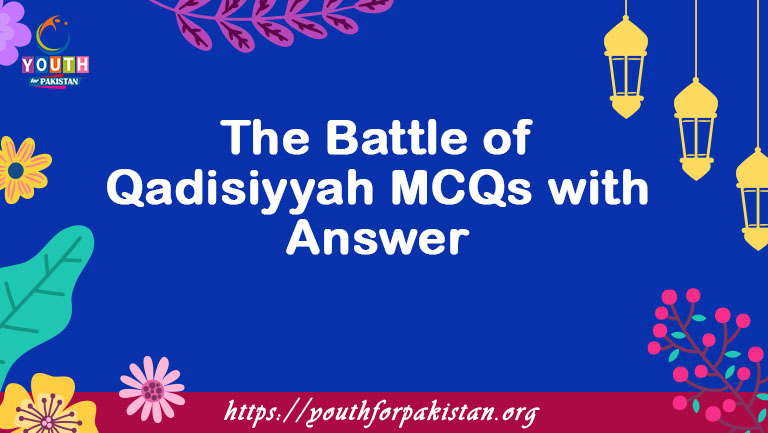The following are The Battle of Qadisiyyah MCQs with answers related to Islamic Studies. We have arranged the most important and repeated MCQs in all the competitive examinations. The students can clear their concepts for The Battle of Qadisiyyah MCQs online quiz by attempting these.
The Battle of Qadisiyyah Online MCQs with Answers
When did the Battle of Qadisiyyah take place?
a) 624 CE
b) 636 CE
c) 656 CE
d) 661 CE
Who were the primary belligerents in the Battle of Qadisiyyah?
a) Muslims and Persians
b) Muslims and Byzantines
c) Muslims and Egyptians
d) Muslims and Arabs
What was the main cause of the Battle of Qadisiyyah?
a) Religious disputes
b) Territorial expansion
c) Economic rivalry
d) Cultural differences
Who led the Muslim forces during the Battle of Qadisiyyah?
a) Khalid ibn al-Walid
b) Umar ibn al-Khattab
c) Ali ibn Abi Talib
d) Abu Bakr
Who commanded the Persian forces in the Battle of Qadisiyyah?
a) Yazdegerd III
b) Rustam Farrokhzad
c) Hormuzan
d) Shahrbaraz
What geographical region did the Battle of Qadisiyyah take place in?
a) Arabia
b) Egypt
c) Mesopotamia
d) Persia
What was the outcome of the Battle of Qadisiyyah?
a) The Muslims were defeated
b) The Persians were defeated
c) It ended in a stalemate
d) Both sides suffered heavy casualties
Which Muslim caliph was in power during the Battle of Qadisiyyah?
a) Abu Bakr
b) Umar ibn al-Khattab
c) Ali ibn Abi Talib
d) Uthman ibn Affan
What role did the Arab tribes play in the Battle of Qadisiyyah?
a) They supported the Persians
b) They remained neutral
c) They supported the Muslims
d) They fought against both sides
What was the ultimate goal of the Muslim conquest of Persia?
a) To spread Islam by force
b) To establish a powerful empire
c) To secure Persian trade routes
d) To gain control of the Persian capital, Ctesiphon
What role did Khalid ibn al-Walid play in the Battle of Qadisiyyah?
a) He was the commander of the Persian forces
b) He was the chief diplomat
c) He was a military commander for the Muslim forces
d) He was not present at the battle
How long did the Battle of Qadisiyyah last?
a) One day
b) One week
c) One month
d) One year
What was the approximate size of the Muslim army at the Battle of Qadisiyyah?
a) 10,000
b) 30,000
c) 50,000
d) 100,000
What significant event followed the Battle of Qadisiyyah in the history of Persia?
a) The fall of the Persian Empire
b) The adoption of Islam as the state religion
c) The loss of most of their territories in the Middle East
d) The rise of a new Persian dynasty
What is the significance of the Battle of Qadisiyyah in Islamic history?
a) It marked the end of the Islamic expansion
b) It solidified the Muslim control of Persia
c) It led to the conversion of Persians to Islam
d) It resulted in the defeat of the Muslims
What military tactics were employed by Khalid ibn al-Walid to secure victory in the Battle of Qadisiyyah?
a) Encirclement
b) Ambush
c) Feigned retreat
d) Naval warfare
How did the Battle of Qadisiyyah contribute to the spread of Islam in Persia?
a) It led to mass conversions of Persians to Islam
b) It allowed the Muslims to establish religious schools in Persia
c) It removed Persian rule and paved the way for Islamic governance
d) It had no impact on the spread of Islam
What was the role of the Arab tribes in supporting the Muslim army at Qadisiyyah?
a) They provided reinforcements to the Persian army
b) They remained neutral and did not participate
c) They offered logistical support and supplies to the Muslims
d) They launched a separate attack against the Muslim forces
How did the Battle of Qadisiyyah affect the status of Khalid ibn al-Walid in Islamic history?
a) He was criticized for his tactics
b) He was remembered as a hero and a brilliant commander
c) He was exiled from the Muslim community
d) He was forgotten in Islamic history
What was the role of Hormuzan, a Persian general, in the Battle of Qadisiyyah?
a) He led the Muslim forces
b) He was a key advisor to the Persian king
c) He defected to the Muslim side and provided valuable information
d) He served as a mediator between the two armies
How did the Battle of Qadisiyyah impact the religious demographics of Persia?
a) It led to the mass conversion of Persians to Christianity
b) It resulted in religious diversity and tolerance in Persia
c) It had no significant impact on the religious demographics
d) It caused the expulsion of all non-Muslims from Persia
What strategic advantage did the Muslim forces gain from their victory at the Battle of Qadisiyyah?
a) Control of the Persian Gulf
b) Access to abundant natural resources
c) Consolidation of their territories in Arabia
d) Secure control of key trade routes
Which caliph ruled during the Battle of Qadisiyyah?
a) Abu Bakr
b) Umar ibn al-Khattab
c) Ali ibn Abi Talib
d) Uthman ibn Affan
How did the Battle of Qadisiyyah contribute to the consolidation of Muslim rule in Persia?
a) It resulted in the immediate conversion of the Persian population to Islam
b) It led to the establishment of stable Islamic governance in Persia
c) It caused a power vacuum and chaos in Persia
d) It had no impact on Muslim rule in Persia
What was the significance of the Tigris River in the Battle of Qadisiyyah?
a) It was the primary source of drinking water for both armies
b) It marked the border between the two empires
c) It created a natural barrier that limited the Persian army’s movement
d) It had no significance in the battle
What was the immediate consequence of the Muslim victory at the Battle of Qadisiyyah for the Persian Empire?
a) The fall of the Persian capital, Ctesiphon
b) The conversion of Persia to Islam
c) The collapse of the Persian government
d) The expulsion of Persians from their own land
Who is often referred to as the “Sword of Allah” due to his military prowess in battles like Qadisiyyah?
a) Umar ibn al-Khattab
b) Khalid ibn al-Walid
c) Ali ibn Abi Talib
d) Abu Bakr
What role did the Persian general Rustam Farrokhzad play in the events leading up to the Battle of Qadisiyyah?
a) He personally led the Persian army in battle
b) He negotiated a peace treaty with the Muslims
c) He ordered a massive military buildup in the region
d) He was absent from the region during the battle
What was the primary motivation for the Muslim forces in the Battle of Qadisiyyah?
a) Economic gain
b) Religious duty and expansion of Islam
c) Revenge against the Persians
d) Securing trade routes
What was the result of the Persian army’s attempt to use elephants in the Battle of Qadisiyyah?
a) The elephants caused significant casualties among the Muslims
b) The elephants were captured by the Persians
c) The elephants panicked and caused disorder in the Persian ranks
d) The elephants had no impact on the battle
What strategy did Khalid ibn al-Walid use to deceive the Persian forces at the Battle of Qadisiyyah?
a) He pretended to retreat and then launched a surprise attack
b) He sent a fake message of surrender to the Persians
c) He built a massive fort to intimidate the Persians
d) He used a network of spies to infiltrate the Persian camp
What was the role of the Euphrates River in the battle’s outcome?
a) It provided a source of drinking water for both armies
b) It marked the border between the two empires
c) It created a natural barrier that limited the Persian army’s movement
d) It had no significance in the battle
How did the Battle of Qadisiyyah contribute to the spread of Islam in Persia?
a) It led to mass conversions of the Persian population to Islam
b) It allowed the Muslims to establish religious schools in Persia
c) It removed Persian rule and paved the way for Islamic governance
d) It had no impact on the spread of Islam
What military tactic was used by Khalid ibn al-Walid to divide and conquer the Persian forces?
a) Encirclement
b) Ambush
c) Feigned retreat
d) Naval warfare
What was the significance of the Battle of Qadisiyyah for the early Muslim community?
a) A decisive victory against the Persians
b) The end of Islamic expansion
c) The importance of diplomacy over warfare
d) A setback in their efforts to spread Islam
What was the impact of the Battle of Qadisiyyah on the Persian Empire’s presence in Mesopotamia?
a) The Persians retained their control over the region
b) The Persians were completely expelled from Mesopotamia
c) The Persians temporarily lost control but regained it later
d) The Persians and Muslims formed a joint government in the region
How did the Battle of Qadisiyyah influence the perception of Khalid ibn al-Walid in Islamic history?
a) He was criticized for his tactics
b) He was remembered as a hero and a brilliant commander
c) He was exiled from the Muslim community
d) He was forgotten in Islamic history
What role did the Persian general Hormuzan play in the events leading up to the Battle of Qadisiyyah?
a) He personally led the Persian army in battle
b) He negotiated a peace treaty with the Muslims
c) He ordered a massive military buildup in the region
d) He defected to the Muslim side and provided valuable information
What was the primary goal of Khalid ibn al-Walid during the Battle of Qadisiyyah?
a) To capture the Persian king
b) To defeat the Persian army decisively
c) To negotiate a peaceful settlement
d) To establish a Muslim state in Persia
What tactics did Khalid ibn al-Walid use to exploit the weakness of the Persian forces?
a) He employed guerrilla warfare tactics
b) He launched a frontal assault on the Persian camp
c) He used spies to gather intelligence on the Persian positions
d) He created a diversion to draw the Persians away from the river
What was the significance of the Battle of Qadisiyyah in the context of Islamic expansion?
a) It marked the final conquest in the name of Islam
b) It symbolized the end of Islamic expansion
c) It accelerated the spread of Islam in the region
d) It had no impact on the Islamic expansion
How did the Battle of Qadisiyyah impact the relationship between the Arab tribes and the emerging Islamic state?
a) It led to a lasting alliance between the Arab tribes and the Muslims
b) It resulted in mistrust and conflict between the two
c) It had no impact on their relationship
d) It led to the isolation of the Arab tribes from the Islamic state
What key lessons can be drawn from the Battle of Qadisiyyah in terms of military strategy?
a) The importance of numerical superiority
b) The significance of surprise attacks
c) The value of diplomacy in avoiding battles
d) The strategic advantage of high ground
What was the long-term impact of the Battle of Qadisiyyah on the relationship between the Persian Empire and the Islamic Caliphate?
a) It led to lasting peace and cooperation between the two powers
b) It resulted in frequent military conflicts and border disputes
c) It marked the beginning of diplomatic relations and trade
d) It had no impact on their relationship
What was the primary motivation for the Persian Empire to engage in the Battle of Qadisiyyah?
a) Expansion of their territory
b) Defense of their homeland
c) Religious conversion of the Muslims
d) Retaliation for a previous battle
What was the significance of the Euphrates River in limiting the mobility of the Persian army during the battle?
a) It provided a source of drinking water for the Persians
b) It allowed the Persians to escape easily
c) It created a bottleneck that hindered the Persian retreat
d) It had no impact on the Persian army’s mobility
How did the Battle of Qadisiyyah influence subsequent military campaigns and strategies in Islamic history?
a) It served as a model for future battles
b) It led to a decline in Islamic military tactics
c) It resulted in a focus on naval warfare
d) It had no impact on subsequent military campaigns
What was the impact of the Battle of Qadisiyyah on the religious composition of Persia?
a) It led to the mass conversion of Persians to Christianity
b) It resulted in religious diversity and tolerance in Persia
c) It had no significant impact on the religious composition
d) It caused the expulsion of all non-Muslims from Persia
What was the primary reason behind the feigned retreat strategy used by Khalid ibn al-Walid at Qadisiyyah?
a) To deceive the Persian forces and create confusion
b) To surrender to the Persians
c) To negotiate a peace treaty
d) To regroup and reorganize the Muslim forces
How did the Battle of Qadisiyyah impact the subsequent expansion of the Islamic Caliphate?
a) It marked the end of Islamic expansion
b) It served as a stepping stone for further conquests
c) It led to internal conflicts within the Muslim community
d) It had no impact on the expansion of the Islamic Caliphate










